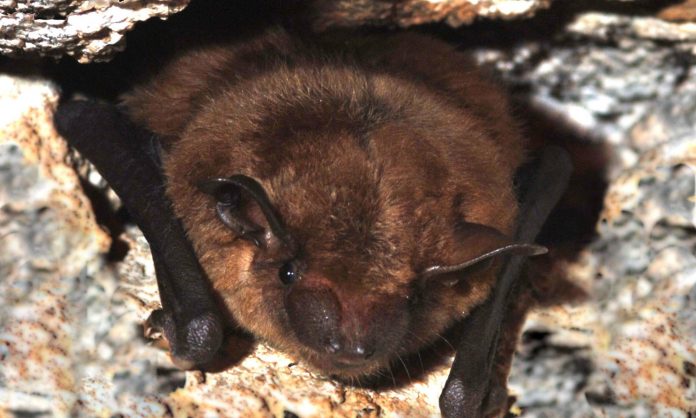
While some folks think bats are creepy and should be shooed away, they are essential to the environment and benefit people, especially those in agriculture. It’s estimated that Ohio’s bats save $1 billion a year in crop loss because of all the insects they eat.
The tricolored bat, the smallest species found in the state, weighs about six grams — the weight of two pennies — while the hoary bat, the biggest in Ohio, can weigh almost six times as much. A bat can eat up to its entire body weight in insects in a single night. Their menu includes night-flying beetles, deer flies and mosquitos.
“That’s thousands of insects per night,” said Eileen Wyza, PhD, the wildlife biologist in charge of terrestrial species of greatest conservation need for the Ohio Division of Wildlife.
Bats find insects in the dark by echolocation. They send out high-pitched vocalizations that we can’t hear but they can and which bounce off the thing they’re after. The closer they get, the more frequent the vocalizations, creating an almost 3-D image of their prey.
Not picky
The dozen or so species of bats seen in Ohio are strictly nocturnal, active from just after sunset to just before sunrise, Wyza said. And while bats in other parts of the world eat nectar, fruit, fish, rodents — and in the case of vampire bats, blood — Ohio’s species eat insects exclusively. And they’re not picky.
“None of our bats are specialists,” she said. “They’ll eat pretty much any kind of insect.”
Bats that stay here year-round have not only adapted to the state’s insect menu but also to Ohio winters. They employ delayed fertilization, mating in the fall “when they’re full of fat and have the energy,” Wyza said.
They hold onto the sperm during hibernation, then fertilize their eggs in spring — after they’ve had a chance to eat some insects and regain some fat stores.
Bats have their babies in May and nurse them for a few weeks. The pups start to fly at about five weeks. By the way, bats are the only mammals that can truly fly, Wyza said. Flying squirrels only glide.
Grounded
The Division of Wildlife often gets calls from late July into August when people may find a baby bat on the ground. That’s because they’re not very good at flying yet. But more importantly, they don’t have the strength to take off from the ground.
Bats hang upside down to sleep during the day, the claws of their feet clinging to tree bark or other rough surfaces. That’s why bat houses have the opening at the bottom, not on the side as bird houses do. When they’re ready to fly, they drop down and then zoom up, like a plane doing aerobatics.
If you find a bat pup on the ground, you can try picking it up — with gloves on — and placing it on a tree trunk, the side of a barn or some other rough surface; anywhere that it can get a flying start.
But if the pup is dehydrated, it might not be able to cling to a vertical surface. In that case, call one of the wildlife rehabilitators listed on the Ohio Department of Natural Resources website, Wyza said.
Endangered
There’s a reason that bats fall under the “terrestrial species of greatest conservation need” in her title. Some, like the Indiana bat, were already on endangered species lists because of their sensitivity to insecticides, loss of forest habitat, etc. But others among Ohio’s bat species have experienced a 95% decline in population since white-nose syndrome appeared here a decade ago.
White-nose syndrome is caused by a fungus that probably came from Europe. It loves the cold and spreads in caves, abandoned mines and other places where bats hibernate during the winter. In later stages, the fungus appears on bats’ muzzles and wings but also causes internal changes, including irritation that makes them wake up prematurely and use up their fat reserves before food is available.
In the past few years, one or two of these endangered bats have been found in surveys, so their population declines have been deemed “stabilized.”
“But that doesn’t mean they’re rebounding,” Wyza said. “We may find a couple of individuals, but we don’t know if that means they can find a summer roosting area, find a mate and have little ones.”
Her agency is trying to help bats by locating trees where they are roosting in summer, then protecting other trees for several miles around it from clearing or development — permanently. That’s doable on public land, like parks. On private land, “we just try to talk to the owners and see if we can convince them to help,” she said.
Homeowners are also encouraged to put up bat houses, grow native plants that attract moths and other insects on the bats’ menu and create long ponds that give bats enough room to swoop down and get a drink as they fly by.
Why would anyone want to attract bats to their home?
“People who do this report fewer mosquitos, deer flies and other pests around the house, plus less damage to food crops,” Wyza said. “Bats are beneficial because they’re great at insect control.”










